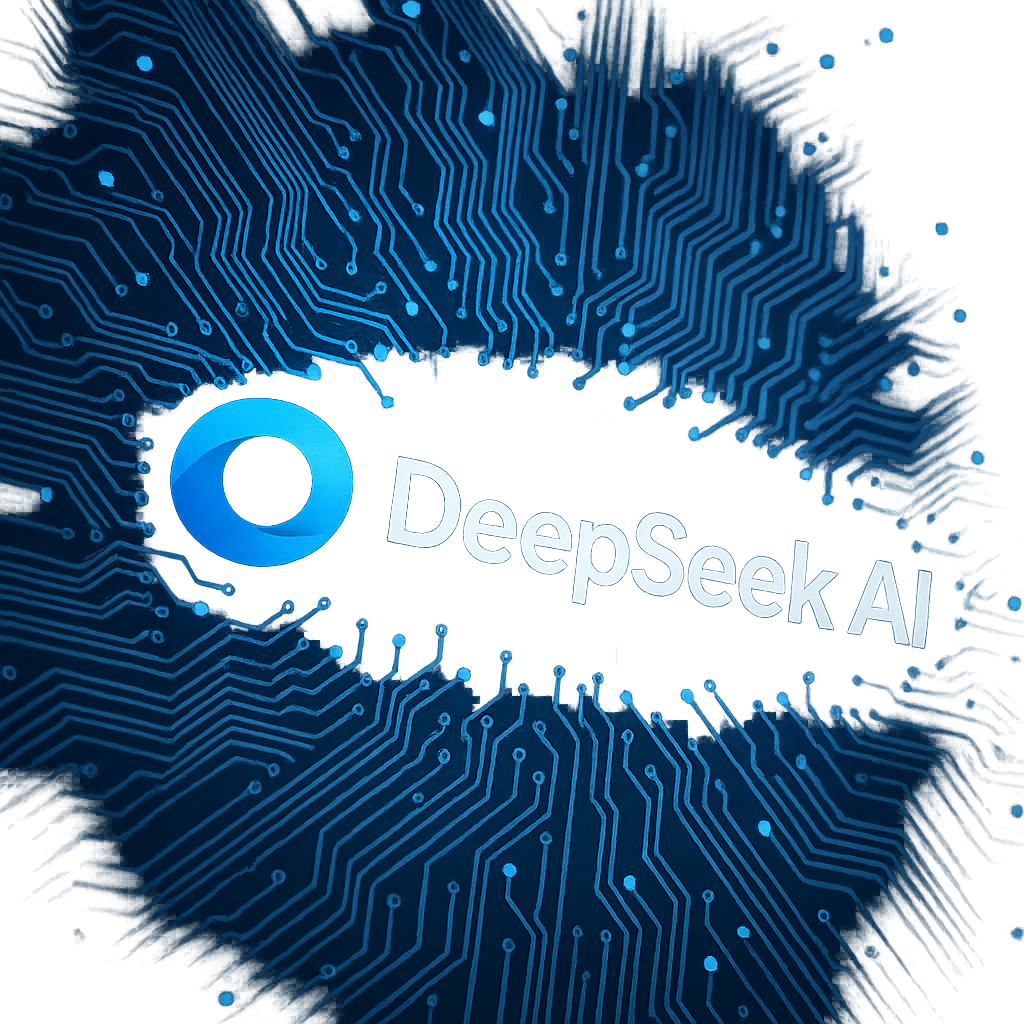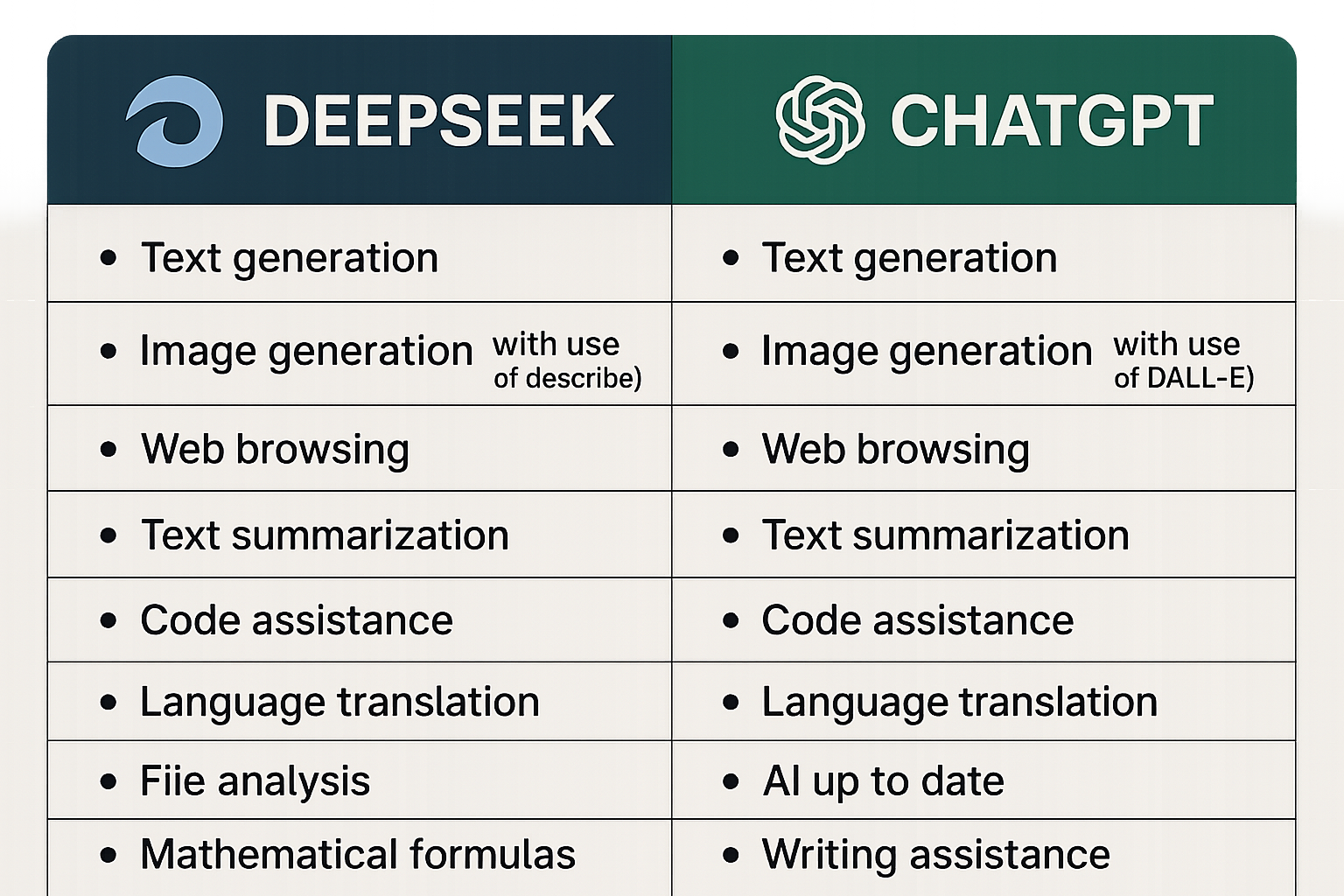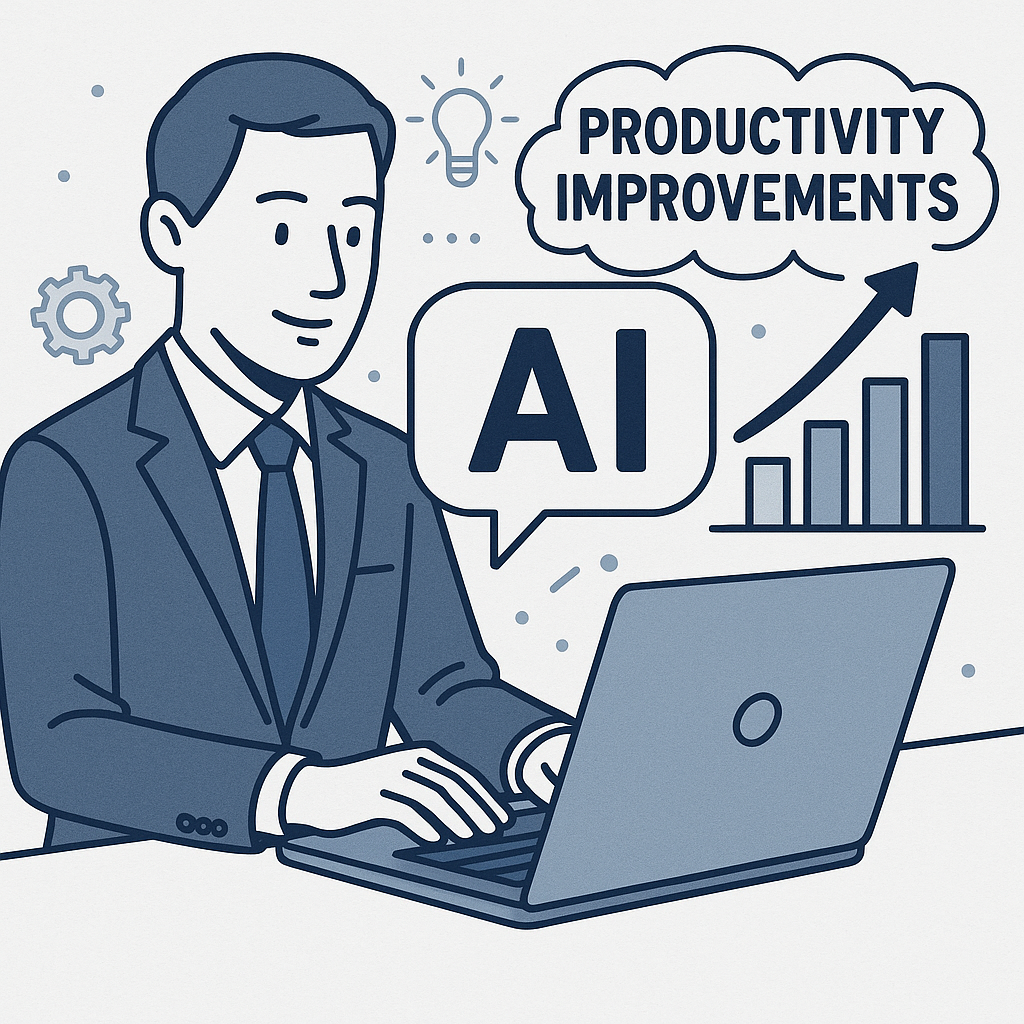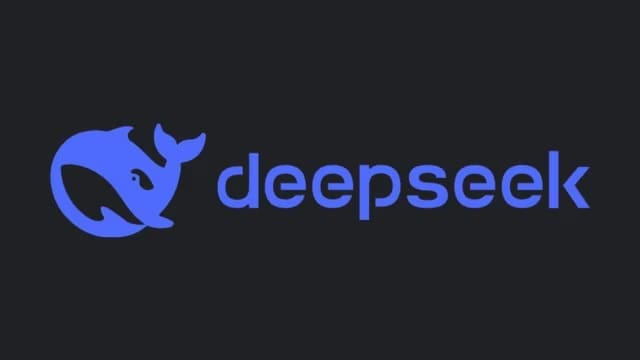What is DeepSeek AI?
DeepSeek AI is a Chinese artificial intelligence company founded in July 2023 by Liang Wenfeng, who also co-founded the quantitative hedge fund High-Flyer. Based in Hangzhou, Zhejiang, DeepSeek has rapidly emerged as a major player in the AI landscape by developing powerful open-source large language models (LLMs) that compete directly with established players like OpenAI and Google.

The company gained international recognition in January 2025 with the release of its DeepSeek-R1 model, which demonstrates performance comparable to OpenAI’s GPT-4 and o1 models while costing significantly less to develop. DeepSeek claims to have trained its models for approximately $6 million, compared to OpenAI’s estimated $100 million cost for GPT-4.
What sets DeepSeek apart is its open-source approach – most of its models are released under the MIT License, allowing developers and researchers worldwide to freely use, modify, and commercialize the technology. This democratization of AI has sent “shock waves” through the industry, challenging the dominance of proprietary AI systems.
How Does DeepSeek AI Work?
DeepSeek AI operates through a sophisticated blend of machine learning, natural language processing, and deep neural networks. The system employs several innovative technical approaches that make it both powerful and cost-effective:
Mixture of Experts (MoE) Architecture
DeepSeek’s models use a Mixture-of-Experts architecture with 671 billion parameters, but only activates approximately 37 billion parameters per query. This selective activation significantly enhances efficiency and performance while reducing computational costs.
Reinforcement Learning Approach
Unlike many competitors that rely heavily on supervised fine-tuning, DeepSeek-R1 features a powerful reinforcement learning (RL) pipeline that learns reasoning through continuous iteration and feedback. This approach enables the model to develop complex reasoning patterns naturally without explicit programming.
Multi-Head Latent Attention (MLA)
The models employ Multi-Head Latent Attention mechanisms that maintain high performance while reducing memory consumption during inference using low-rank compression techniques.
Multi-Token Prediction (MTP)
DeepSeek incorporates Multi-Token Prediction capabilities, enabling the model to predict multiple tokens simultaneously, which increases generation speed and improves overall efficiency.
What are DeepSeek AI’s Key Features?
DeepSeek AI offers several distinctive features that make it a compelling choice for users and developers:
Advanced Reasoning Capabilities
DeepSeek-R1 excels in logic-based tasks and complex problem-solving, achieving a 90% accuracy rate in mathematics – notably higher than many competitors. The model demonstrates superior performance in coding challenges, ranking in the 89th percentile on Codeforces.
Large Context Window
The models support a 128,000-token context window, making them ideal for complex tasks like code reviews, legal document analysis, or multi-step mathematical problem-solving.
High Output Capacity
DeepSeek can generate up to 32,000 tokens at once, making it well-suited for writing in-depth reports or analyzing large datasets.
Open-Source Accessibility
Unlike proprietary models, DeepSeek’s open-weight models allow users to download and run them locally on their own hardware, providing complete control over data and privacy.
Cost Efficiency
The inference cost of DeepSeek R1 is estimated to be only 2-3% of OpenAI’s model costs, making it accessible to independent developers and small businesses.
How Much Does DeepSeek AI Cost?
DeepSeek offers a unique pricing structure that differs significantly from traditional subscription-based AI services:
Free Access
DeepSeek provides completely free access to its web interface and mobile applications, with no usage limits for basic functionality. Users can access DeepSeek-V3 and R1 models without any subscription fees.
API Pricing (Pay-as-You-Go)
For developers and businesses wanting to integrate DeepSeek into their applications, the API follows a token-based pricing model:
DeepSeek-V3: $0.27 per 1M input tokens, $1.10 per 1M output tokens
DeepSeek-R1: $0.55 per 1M input tokens, $2.19 per 1M output tokens
Volume Discounts
The platform offers automatic discounts during off-peak hours (UTC 16:30–00:30), with savings of up to 50-75% for requests made during these times.
Cost Comparison
Compared to competitors, DeepSeek offers significant savings:
200x cheaper than GPT-4 Turbo for similar capabilities
98%+ cost reduction for businesses using AI at scale
No minimum fees or lock-in contracts
How to Get Started with DeepSeek AI?
Getting started with DeepSeek AI is straightforward and accessible to users of all technical levels:
Web Interface
Visit deepseek.com and click “Start”
Create a free account with your email address
Start chatting immediately with DeepSeek-V3 or R1 models
No credit card required for basic usage
Mobile Applications
DeepSeek offers mobile apps for both iOS and Android platforms:
Download from Apple App Store or Google Play Store
Sign in with your account credentials
Access full functionality on mobile devices
API Access
For developers wanting to integrate DeepSeek into applications:
Sign up on the DeepSeek API platform
Generate an API key from the dashboard
Add credits to your account (if using paid features)
Use the OpenAI-compatible SDK for integration
from openai import OpenAIclient = OpenAI(
api_key=“your-deepseek-api-key”,
base_url=“https://api.deepseek.com”
)response = client.chat.completions.create(
model=“deepseek-chat”,
messages=[
{“role”: “system”, “content”: “You are a helpful assistant”},
{“role”: “user”, “content”: “Hello”}
]
)
Local Installation
For advanced users, DeepSeek models can be downloaded and run locally:
Models are available on GitHub and Hugging Face
Requires compatible hardware (minimum 16GB RAM recommended)
Provides complete privacy and offline functionality
DeepSeek AI vs ChatGPT: Which is Better?
The comparison between DeepSeek AI and ChatGPT reveals distinct strengths and use cases for each platform:

Performance Comparison
| Feature | DeepSeek R1 | ChatGPT |
|---|---|---|
| Mathematics | 90% accuracy | 83% accuracy |
| Coding | 97% success rate in logic puzzles | Strong performance, comparable |
| Reasoning | RL-driven step-by-step explanations | Superior multi-step problem-solving |
| Context Window | 128K tokens | 200K tokens |
| Multimodal | Text-only focus | Supports text and images |
Key Differences
DeepSeek Advantages:
Cost-effective: Free for most users, API costs 200x less than GPT-4
Open-source: Full control over models and data
Reasoning: Excels in logic-based tasks and mathematical problems
Privacy: Can be run locally without data sharing
ChatGPT Advantages:
Multimodal: Handles text, images, and voice interactions
Memory: Remembers details from past conversations
Ecosystem: Better integration with third-party services
Reliability: More stable infrastructure and availability
Best Use Cases
Choose DeepSeek for:
Budget-conscious projects
Mathematical and coding tasks
Privacy-sensitive applications
Open-source development
Choose ChatGPT for:
Multimodal applications
General-purpose conversational AI
Creative writing and content generation
Enterprise integrations
What are the Business Applications of DeepSeek AI?
DeepSeek AI has found practical applications across numerous industries, demonstrating its versatility and effectiveness:

Healthcare and Medical
Medical Imaging Analysis: Hospitals use DeepSeek to analyze CT scans, X-rays, and MRIs for early disease detection
COVID-19 Detection: Healthcare providers employed the AI to process chest CT scans and identify infection patterns
Drug Discovery: Pharmaceutical companies leverage DeepSeek to predict molecular interactions and accelerate R&D timelines
Financial Services
Fraud Detection: Major banks use DeepSeek to analyze transaction data and identify suspicious behavior patterns
Market Analysis: Investment firms employ the AI for trend identification and data-driven trading decisions
Credit Scoring: Financial institutions utilize DeepSeek for risk assessment and loan approval processes
Technology and Development
Code Review: Development teams use DeepSeek for automated code analysis and debugging assistance
Cybersecurity: Tech companies employ the AI for threat detection and network monitoring
Software Development: Businesses leverage DeepSeek’s coding capabilities for application development and testing
Manufacturing and Operations
Predictive Maintenance: Factories use DeepSeek to analyze sensor data and predict equipment failures
Quality Control: Manufacturing companies employ the AI for automated inspection and defect detection
Supply Chain Optimization: Businesses use DeepSeek for demand forecasting and inventory management
Marketing and E-commerce
Personalized Recommendations: E-commerce platforms use DeepSeek to analyze customer behavior and suggest products
Content Creation: Marketing teams employ the AI for copywriting and campaign development
Customer Support: Companies implement DeepSeek-powered chatbots for 24/7 customer service
What are the Privacy and Security Concerns?
While DeepSeek offers powerful capabilities, several privacy and security considerations must be addressed:
Data Collection Practices
DeepSeek’s privacy policy indicates the collection of extensive user data:
Personal Information: Name, email address, and account details
Usage Data: Chat history, search queries, and interaction patterns
Device Information: IP addresses, browser details, and keystroke patterns
Third-party Data: Information from login services and analytics providers
Data Storage Location
A primary concern is that DeepSeek stores user data on servers located in China. This raises several issues:
Government Access: Chinese data protection laws differ from Western standards
GDPR Compliance: Potential violations for European users
Corporate Security: Risk of state-sponsored access to business data
Security Incidents
DeepSeek has experienced several security challenges:
Cyberattacks: The company faced malicious attacks that forced temporary service restrictions
Data Exposure: Researchers discovered publicly accessible databases with sensitive information
Vulnerabilities: The models are susceptible to “jailbreak” exploits that bypass safety filters
Mitigation Strategies
Users can reduce privacy risks through several approaches:
Local Deployment: Run DeepSeek models locally to avoid data transmission
Third-party Hosting: Use platforms like Perplexity that host models in US/EU data centers
Data Minimization: Limit sensitive information shared with the AI
Regular Audits: Monitor data usage and implement access controls
What are the Limitations of DeepSeek AI?
Despite its impressive capabilities, DeepSeek AI has several notable limitations that users should consider:
Technical Limitations
No Multimodal Capabilities: DeepSeek is primarily text-based and cannot process images, videos, or audio inputs. This limits its applicability compared to competitors like ChatGPT or Google Gemini.
Knowledge Cutoff: The training data only extends to July 2023, meaning the model lacks awareness of recent events, trends, or discoveries.
No Real-time Data Access: DeepSeek cannot browse the internet or retrieve live information such as current weather, stock prices, or breaking news.
Performance Issues
Server Reliability: Users frequently report that “DeepSeek’s server is always busy,” leading to accessibility issues and service interruptions. The platform struggles with:
High demand causing server overload
Limited server capacity compared to established competitors
Frequent 503 Service Unavailable errors
Contextual Understanding: The model sometimes loses track of context in very long conversations or when users refer to earlier messages without clarity.
Safety and Content Concerns
Vulnerability to Exploits: DeepSeek R1 is susceptible to “jailbreak” exploits that allow users to bypass safety filters, potentially generating harmful or inappropriate content.
Higher Risk of Harmful Output: Independent evaluations show DeepSeek R1 is 11× more likely to produce dangerous outputs and 4× more likely to create insecure code compared to Western alternatives.
Content Censorship: Due to its Chinese origins, DeepSeek implements content restrictions around sensitive political topics that may limit its usefulness for certain discussions.
Business and Regulatory Challenges
Trademark Disputes: DeepSeek faces potential legal issues in the U.S. market due to trademark conflicts.
Regulatory Scrutiny: The platform is under investigation by various governments for data privacy and national security concerns.
Limited Integration: Unlike established platforms, DeepSeek has fewer third-party integrations and enterprise-grade features.
What are the Best DeepSeek AI Alternatives?
For users seeking alternatives to DeepSeek AI, several powerful options are available in 2025:
Top Competitors
1. ChatGPT by OpenAI
Strengths: Multimodal capabilities, strong ecosystem, reliable infrastructure
Best for: General-purpose AI tasks, creative writing, enterprise applications
Pricing: Free tier available, $20/month for Pro
2. Claude by Anthropic
Strengths: Ethical AI focus, long-form content generation, safety features
Best for: Research, analysis, sensitive content handling
Pricing: Free tier with limits, $20/month for Pro
3. Google Gemini
Strengths: Real-time web data access, Google ecosystem integration, multimodal
Best for: Research, productivity, Google Workspace users
Pricing: Free with Google account
4. Perplexity AI
Strengths: Cited responses, real-time information, research focus
Best for: Academic research, fact-checking, current events
Pricing: Free tier, $20/month for Pro
5. Meta AI (Llama)
Strengths: Open-source, customizable, privacy-focused
Best for: Custom applications, privacy-sensitive use cases
Pricing: Free (open-source)
Specialized Alternatives
For Business Users:
Microsoft Copilot: Deep Office 365 integration, enterprise features
Team-GPT: Collaboration-focused, team management tools
For Developers:
Qwen AI: Advanced coding capabilities, technical documentation
Hugging Face: Open-source model hosting and fine-tuning
For Content Creation:
Jasper.ai: Marketing-focused, SEO optimization
ChatSonic: Content generation with SEO tools
What’s the Future of DeepSeek AI?
DeepSeek’s roadmap for 2025 and beyond shows ambitious plans for expanding its AI capabilities and market presence:
Upcoming Features in 2025
Enhanced Multimodal Capabilities: DeepSeek plans to release vision-language models that can process both text and images, addressing one of its current major limitations.
Improved Coding Tools: DeepSeek Coder 2.0 is expected to launch in Q2 2025, offering enhanced programming assistance and debugging capabilities.
Edge Computing Optimization: The company is developing compact models under 1B parameters for mobile and IoT devices, enabling offline functionality.
Private Hosting Solutions: DeepSeek will offer self-hosting capabilities for enterprises, allowing organizations to run models on private infrastructure while maintaining compliance with regulations like GDPR and HIPAA.
Long-term Innovations
Green AI Initiatives: DeepSeek is investing in energy-efficient training methods to reduce the carbon footprint of AI development, including quantization-aware distillation and sparse activation techniques.
Multilingual Expansion: Plans include support for over 100 languages, with focus on low-resource and indigenous languages to promote global accessibility.
Plugin Ecosystem: A marketplace and SDK for third-party plugins will enable developers to extend LLM functionality and create custom applications.
Market Outlook
Global Expansion: Despite regulatory challenges, DeepSeek aims to expand internationally while navigating geopolitical tensions and compliance requirements.
Competition Response: The company’s success has prompted established AI giants to reconsider their pricing strategies and development approaches, intensifying market competition.
Technology Democratization: DeepSeek’s open-source approach continues to influence the industry toward more accessible and customizable AI solutions.
Challenges and Risks
Regulatory Pressure: Increasing scrutiny from Western governments may limit DeepSeek’s global expansion and require significant compliance investments.
Infrastructure Scaling: The company must address current capacity constraints and server reliability issues to maintain growth momentum.
Technical Competition: Rapid advancement by competitors like OpenAI, Google, and Anthropic presents ongoing challenges for market positioning.
Frequently Asked Questions
Is DeepSeek AI completely free to use?
Yes, DeepSeek offers free access to its web interface and mobile applications with no usage limits for basic functionality. However, API access for developers follows a pay-as-you-go model with very competitive pricing.
Can DeepSeek AI work offline?
Yes, DeepSeek models can be downloaded and run locally on compatible hardware, providing complete offline functionality and data privacy. This requires technical setup and sufficient computing resources.
How does DeepSeek compare to ChatGPT in terms of performance?
DeepSeek excels in mathematical and coding tasks, achieving 90% accuracy in mathematics compared to ChatGPT’s 83%. However, ChatGPT offers better multimodal capabilities and ecosystem integration.
Is DeepSeek AI safe for business use?
While DeepSeek offers powerful capabilities, businesses should carefully consider data privacy implications, especially regarding data storage in China. For sensitive applications, local deployment or third-party hosting may be preferable.
What programming languages does DeepSeek support?
DeepSeek provides strong support for major programming languages including Python, JavaScript, Java, C++, and many others, with particular strength in debugging and code optimization.
Can DeepSeek AI generate images?
Currently, DeepSeek is primarily text-based and cannot generate images. However, the company plans to introduce multimodal capabilities including image processing in 2025.
How reliable is DeepSeek’s server infrastructure?
DeepSeek has experienced capacity issues due to high demand, leading to frequent server busy messages and service interruptions. The company is working to improve infrastructure reliability.
What makes DeepSeek different from other AI models?
DeepSeek’s key differentiators include its open-source approach, extremely low cost of development and operation, focus on reasoning capabilities, and innovative Mixture-of-Experts architecture.
Is DeepSeek available in multiple languages?
Yes, DeepSeek supports multiple languages, with plans to expand to over 100 languages including low-resource languages by 2025. However, performance may vary across different languages.
How can I integrate DeepSeek into my existing applications?
DeepSeek provides an OpenAI-compatible API that can be easily integrated into existing applications using standard SDKs. The platform offers comprehensive documentation and examples for developers.
DeepSeek AI represents a significant shift in the artificial intelligence landscape, offering powerful capabilities at unprecedented low costs while maintaining an open-source approach. While it faces challenges related to privacy, regulatory compliance, and infrastructure scaling, its innovative technical approach and cost-effectiveness make it a compelling option for many users and businesses. As the platform continues to evolve and address its limitations, it has the potential to further democratize access to advanced AI technologies worldwide.




Pingback: Sustainable Business Practices: The New Corporate Imperative | TechOreo Blog
Pingback: SearchGPT Guide 2025: AI Search Engine for Beginners | TechOreo Blog
Pingback: GEO Guide: Generative Engine Optimization for 2025 | TechOreo Blog